 Hubble Space Telescope spectra obtained in 2010 and 2011, three and four years after the large amplitude dwarf nova outburst of V455 And, were combined with optical photometry and spectra to study the cooling of the white dwarf, its spin, and possible pulsation periods after the outburst. The modeling of the ultraviolet (UV) spectra show that the white dwarf temperature remains ~600 K hotter than its quiescent value at three years post outburst, and still a few hundred degrees hotter at four years post outburst. The white dwarf spin at 67.6 s and its second harmonic at 33.8 s are visible in the optical within a month of outburst and are obvious in the later UV observations in the shortest wavelength continuum and the UV emission lines, indicating an origin in high temperature regions near the accretion curtains. The UV light curves folded on the spin period show a double-humped modulation consistent with two-pole accretion. The optical photometry two years after outburst shows a group of frequencies present at shorter periods (250-263 s) than the periods ascribed to pulsation at quiescence, and these gradually shift toward the quiescent frequencies (300-360 s) as time progresses past outburst. The most surprising result is that the frequencies near this period in the UV data are only prominent in the emission lines, not the UV continuum, implying an origin away from the white dwarf photosphere. Thus, the connection of this group of periods with non-radial pulsations of the white dwarf remains elusive.
Hubble Space Telescope spectra obtained in 2010 and 2011, three and four years after the large amplitude dwarf nova outburst of V455 And, were combined with optical photometry and spectra to study the cooling of the white dwarf, its spin, and possible pulsation periods after the outburst. The modeling of the ultraviolet (UV) spectra show that the white dwarf temperature remains ~600 K hotter than its quiescent value at three years post outburst, and still a few hundred degrees hotter at four years post outburst. The white dwarf spin at 67.6 s and its second harmonic at 33.8 s are visible in the optical within a month of outburst and are obvious in the later UV observations in the shortest wavelength continuum and the UV emission lines, indicating an origin in high temperature regions near the accretion curtains. The UV light curves folded on the spin period show a double-humped modulation consistent with two-pole accretion. The optical photometry two years after outburst shows a group of frequencies present at shorter periods (250-263 s) than the periods ascribed to pulsation at quiescence, and these gradually shift toward the quiescent frequencies (300-360 s) as time progresses past outburst. The most surprising result is that the frequencies near this period in the UV data are only prominent in the emission lines, not the UV continuum, implying an origin away from the white dwarf photosphere. Thus, the connection of this group of periods with non-radial pulsations of the white dwarf remains elusive.
Authors: Paula Szkody, Anjum S. Mukadam, Boris T. Gaensicke, Arne Henden, Edward M. Sion, Dean M. Townsley, Damian Christian, Ross E. Falcon, Stylianos Pyrzas, Justin Brown, Kelsey Funkhouser
http://arxiv.org/pdf/1309.1217v1.pdfhttp://arxiv.org/pdf/1309.1217v1.pdf

